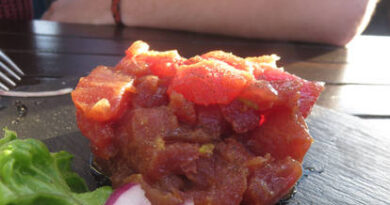Skilpadjies
Exploring the Delightful World of Skilpadjies: A South African Culinary Gem
Introduction:
South African cuisine is a vibrant tapestry of flavors, reflecting the country’s rich cultural diversity. Among the many culinary delights that grace the tables of South African households and braai (barbecue) gatherings, one dish stands out for its unique taste and cultural significance – Skilpadjies. These delectable morsels are a true embodiment of South African gastronomy, offering a delightful combination of tradition and innovation.
Origins and Significance:
Skilpadjies, also known as “skilpadjiekos” or colloquially as “skopies,” have roots deeply embedded in South Africa’s Afrikaans-speaking communities. The name “skilpadjies” translates to “little tortoises” in Afrikaans, a reference to the dish’s small, rolled-up appearance resembling a tortoise shell.
Traditionally, skilpadjies were made using lamb liver and minced lamb’s fat, wrapped in netvet (caul fat) – a thin, lacy membrane that surrounds the internal organs of animals. This unique ingredient not only imparts a distinct flavor but also helps keep the skilpadjies moist during cooking. Over time, variations of skilpadjies have emerged, with some recipes incorporating spices, herbs, and alternative meats.
Ingredients and Preparation:
The classic skilpadjies recipe requires a handful of simple ingredients, highlighting the straightforward yet delicious nature of this dish. Here’s a basic recipe to get you started:
Ingredients:
- Lamb liver, finely chopped
- Lamb’s fat (alternatively, beef or pork fat), minced
- Caul fat (netvet), soaked in water and cleaned
- Salt and pepper to taste
- Optional: Herbs and spices such as coriander, cumin, or garlic for added flavor
Instructions:
- Clean the lamb liver thoroughly and finely chop it.
- Mix the chopped liver with minced lamb’s fat.
- Season the mixture with salt, pepper, and optional herbs and spices.
- Cut the caul fat into squares and wrap each square around a portion of the liver and fat mixture, forming small parcels.
Grilling and Serving:
Skilpadjies are best enjoyed on the grill, adding a smoky flavor that enhances their richness. The following steps will guide you through the grilling process:
- Preheat the grill to medium-high heat.
- Place the skilpadjies on the grill and cook for about 10-15 minutes, turning them occasionally to ensure even cooking.
- Once the caul fat is crispy and the filling is cooked through, remove the skilpadjies from the grill.
- Allow them to rest for a few minutes before serving.
Accompaniments and Pairings:
Skilpadjies are often served as part of a traditional South African braai, accompanied by a variety of side dishes. Common accompaniments include freshly baked bread, chutneys, and salads. For a complete cultural experience, pair skilpadjies with a glass of South African red wine or a locally brewed beer.
Variations and Modern Twists:
While the classic skilpadjies recipe remains a beloved tradition, modern chefs and home cooks have explored creative variations to suit different tastes. Some recipes introduce unique spices, while others experiment with alternative meats such as beef, pork, or game meats.
Health Considerations:
While skilpadjies are undoubtedly delicious, it’s essential to enjoy them in moderation, considering the high fat content. For those looking for a healthier option, lean meats and reduced-fat alternatives can be incorporated into the filling.
Conclusion:
Skilpadjies are more than just a culinary delight – they are a celebration of South African culture and heritage. From the traditional method of using lamb liver and caul fat to contemporary twists that embrace a variety of flavors, skilpadjies continue to captivate the taste buds of those lucky enough to experience them. So, whether you’re at a South African braai or trying your hand at grilling these little tortoises at home, skilpadjies are sure to leave a lasting impression of flavor and tradition.



